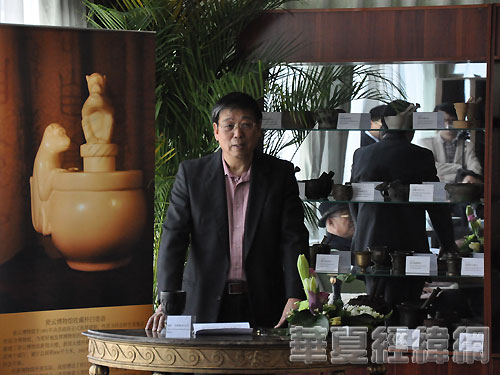Mortar and pestle decipher the commonality of cultures
- By Wu Jin
 0 Comment(s)
0 Comment(s) Print
Print E-mail China.org.cn, May 3, 2013
E-mail China.org.cn, May 3, 2013
Dozens of mortars and pestles that were recently displayed at the Diplomatic Residence Compound in Jianguomen, Beijing, represent the commonality of the different cultures that was shared during the more primitive age of human race.
Despite featuring different materials and shapes, the exhibits display examples of round mortars and straight pestles, which were functional tools once used to crush and grind rice, garlic and herbs.
 |
|
Jiang Yiping at the exhibition room [photo: sohu.com] |
Traditional applications for mortar and pestle, such as food processing or in the use of preparing pharmaceuticals, fell out of use during the industrial era. Such devices are now making their ways into museums and personal collections, and stand as tribute to a bygone era.
"Mortar and pestle were frequently used in common households by people in ages past", said Jiang Yiping, a retired researcher and collector attending the exhibition. "They are shared by the international community and have become a cultural symbol abroad. Overseas exhibitions are often more exciting than those held in China."
Having spent more than a decade searching for and studying mortars and pestles, Jiang is essentially a domestic expert. Jiang has purchased a variety of mortars and pestles, including unique models from Costa Rica, New Zealand and China.
"When I discovered that the mortar and pestle was mentioned by Du Fu (a famous Chinese poet in Tang Dynasty (618-907)) 'only hear the sounds of mortar and pestle day after day,' I was so excited that I could not sleep that night."
According to Jiang, despite their commonality in general utility, the mortar and pestle signal different cultural connotations in different countries. For example, the mortar and pestle signifies a spirit of friendship and self-sacrifice in Japan, because Japanese temples use them to turn rice into glutinous rice. Jiang said the Japanese called the rubbing the pestle’s self-sacrifice.
Meanwhile, he recalled the late writer Israel Epstein saying in 2003 that the mortar and pestle are a symbol of healing in old-fashioned western medicine. Jiang noted that many pharmaceutical stores use the mortar and pestle as their logos in western countries.
"Even the popular green tea powder in Taiwan is a cultural heritage made out by mortars and pestles. This is the culture we need to inherit," Jiang said.






Go to Forum >>0 Comment(s)